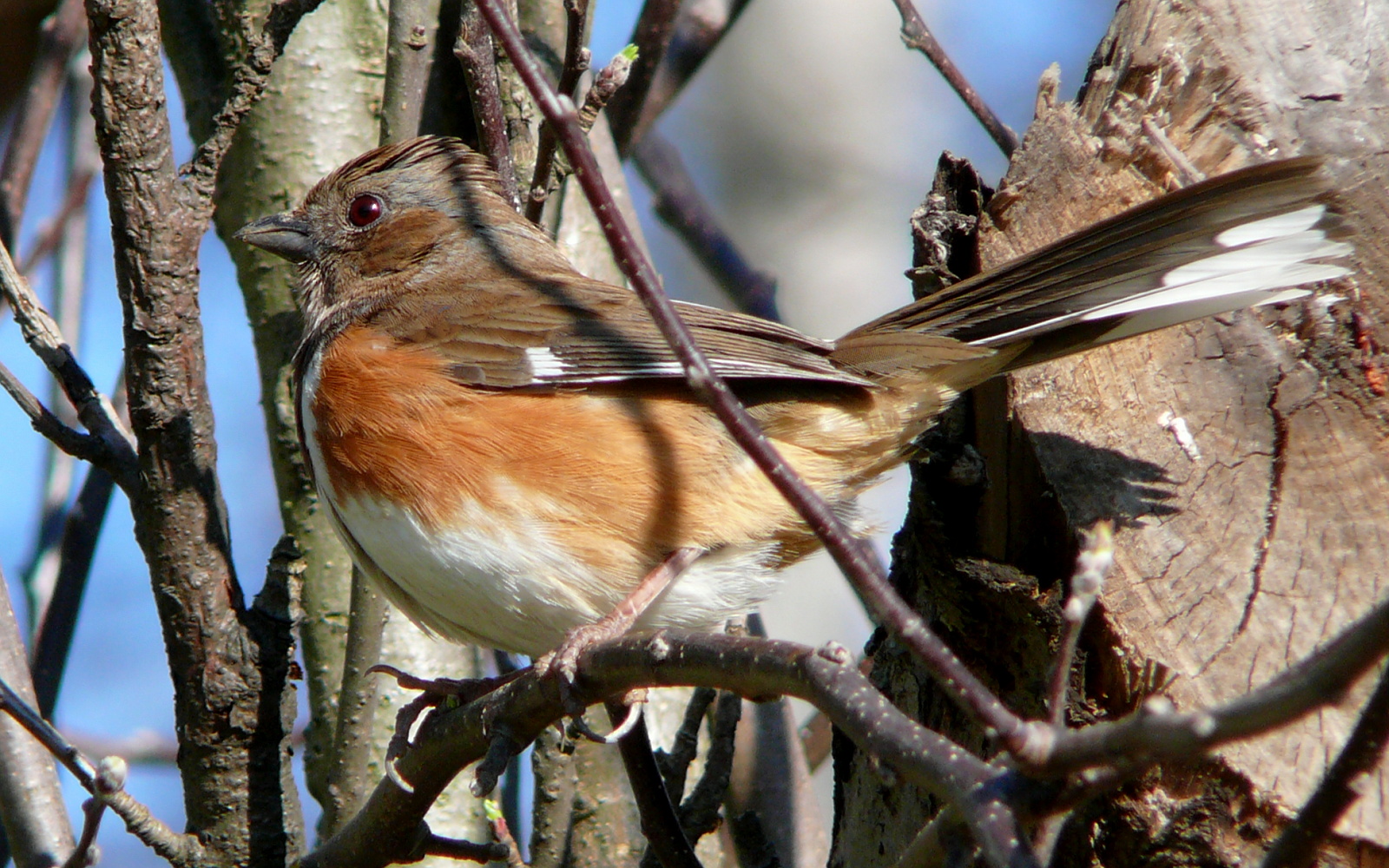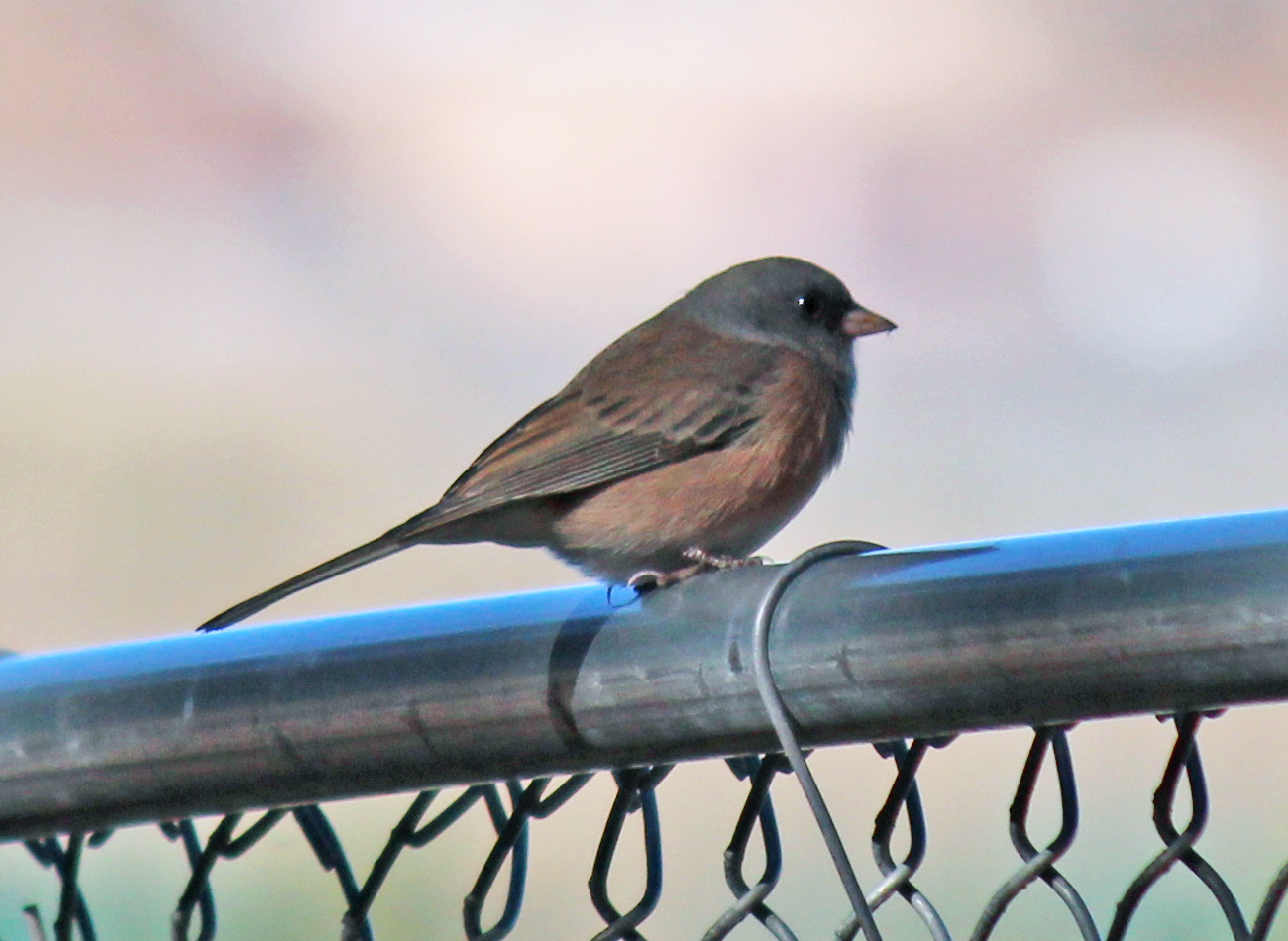|
Towhees
A towhee is any one of a number of species of birds in the genus ''Pipilo'' or ''Melozone'' within the family Passerellidae (which also includes American sparrows, and juncos). Towhees typically have longer tails than other Passerellidae. Most species tend to avoid humans, so they are not well known, though the eastern towhee ''P. erythrophthalmus'' is bolder. This species, and some others, may be seen in urban parks and gardens. There has been considerable debate over the taxonomy of the towhees in recent years. Two species complexes have been identified, the rufous-sided complex (involving ''Pipilo erythrophthalmus'', ''P. maculatus'', ''P. socorroensis'', ''P. ocai'' and ''P. chlorurus''), and the brown towhee complex (involving ''Melozone crissalis'', ''M. fuscus'', ''M. aberti'' and ''M. albicollis''). The distinction of species within these is uncertain and opinions have differed over the years. Modern authorities distinguish all four species in the brown towhee complex, ... [...More Info...] [...Related Items...] OR: [Wikipedia] [Google] [Baidu] |
Eastern Towhee
The eastern towhee (''Pipilo erythrophthalmus'') is a large New World sparrow. The taxonomy of the towhees has been under debate in recent decades, and formerly this bird and the spotted towhee were considered a single species, the rufous-sided towhee. Their breeding habitat is brushy areas across eastern North America. They nest either low in bushes or on the ground under shrubs. Northern birds migrate to the southern United States. There has been one record of this species as a vagrant to western Europe: a single bird in Great Britain in 1966. The song is a short ''drink your teeeeea'' lasting around one second, starting with a sharp call ("drink!") and ending with a short trill "teeeeea". The name "towhee" is onomatopoeic description of one of the towhee's most common calls, a short two-part call rising in pitch and sometimes also called a "chewink" call. Taxonomy The eastern towhee was described by the Swedish naturalist Carl Linnaeus in 1758 in the tenth edition of h ... [...More Info...] [...Related Items...] OR: [Wikipedia] [Google] [Baidu] |
California Towhee
The California towhee (''Melozone crissalis'') is a bird of the family Passerellidae, native to the coastal regions of western Oregon and California in the United States and Baja California Sur in Mexico. The taxonomy of this species has been debated. At the higher level, some authors place the towhees in the family Fringillidae. Within the group, there has been debate about whether the distinction between this species and the similar canyon towhee (''Melozone fuscus'') should be at the specific or subspecific level. The two species used to be grouped together as the brown towhee, yet today they are identified separately, especially because of their differing feather coloration, and the canyon towhee's dark central breast spot. The two populations are quite isolated from each other, and molecular genetics seems to have settled the matter in favour of two distinct species for the present. On the other hand, there seems to be little distinction between the northern and Baja Califo ... [...More Info...] [...Related Items...] OR: [Wikipedia] [Google] [Baidu] |
Spotted Towhee
The spotted towhee (''Pipilo maculatus'') is a large New World sparrow. The taxonomy of the towhees has been debated in recent decades, and until 1995 this bird and the eastern towhee were considered a single species, the rufous-sided towhee. Another outdated name for the spotted towhee is the Oregon towhee (''Pipilo maculatus oregonus''). The call may be harsher and more varied than for the eastern towhee. Individuals in the Socorro Island population are much smaller than other spotted towhees, and show distinctive gray upper-parts. That population is sometimes treated as a subspecies: the Socorro towhee (''Pipilo socorroensis''). Description The spotted towhee is a large New World sparrow, roughly the same size as a robin. It has a long, dark, fan-shaped tail with white corners on the end. It has a round body (similar to New World sparrows) with bright red eyes and dull pink legs. The spotted towhee is between and long, and weighs in at between and . It has a wingspan ... [...More Info...] [...Related Items...] OR: [Wikipedia] [Google] [Baidu] |
Spotted Towhee (Pipilo Maculatus)
The spotted towhee (''Pipilo maculatus'') is a large New World sparrow. The taxonomy of the towhees has been debated in recent decades, and until 1995 this bird and the eastern towhee were considered a single species, the rufous-sided towhee. Another outdated name for the spotted towhee is the Oregon towhee (''Pipilo maculatus oregonus''). The call may be harsher and more varied than for the eastern towhee. Individuals in the Socorro Island population are much smaller than other spotted towhees, and show distinctive gray upper-parts. That population is sometimes treated as a subspecies: the Socorro towhee (''Pipilo socorroensis''). Description The spotted towhee is a large New World sparrow, roughly the same size as a robin. It has a long, dark, fan-shaped tail with white corners on the end. It has a round body (similar to New World sparrows) with bright red eyes and dull pink legs. The spotted towhee is between and long, and weighs in at between and . It has a wingspa ... [...More Info...] [...Related Items...] OR: [Wikipedia] [Google] [Baidu] |
Canyon Towhee
The canyon towhee (''Melozone fusca'') is a bird of the family Passerellidae. Taxonomy The taxonomy of the group of towhees to which this species belongs is debated. At the higher level, some authors place the towhees in the family Fringillidae. Within the genus, there has been dispute about whether the canyon towhee is a distinct species from the California towhee (''Melozone crissalis'') found in coastal regions from Oregon and California in the United States through Baja California in Mexico. At present, molecular genetics seems to have settled this issue in favour of separation of the species. Description It is long, and has a noticeably long tail, at .''Sparrows and Buntings: A Guide to the Sparrows and Buntings of North America and the World'' by Clive Byers & Urban Olsson. Houghton Mifflin (1995). . This species weighs from , though on average weigh only around .''CRC Handbook of Avian Body Masses'' by John B. Dunning Jr. (Editor). CRC Press (1992), . Among standard mea ... [...More Info...] [...Related Items...] OR: [Wikipedia] [Google] [Baidu] |
Green-tailed Towhee
The green-tailed towhee (''Pipilo chlorurus'') is the smallest towhee, but is still one of the larger members of the American sparrow family Passerellidae. Its breeding range covers most of the interior Western United States, with a winter range in Mexico and the southern edge of the Southwestern United States. This bird can be recognized by the bright green stripes on the edge of its wings. It has a distinct white throat and a rufous cap. It measures long and weighs . It is fairly tame, but often stays hidden under a bush. It is fairly common in habitats with sagebrush and other such bushes. It is uncommonly seen because of its tendency to stay under cover. References Further reading Book * Thesis * Beedy EC. Ph.D. (1982). ''Bird Community Structure in Coniferous Forests of Yosemite National Park, California''. University of California, Davis, United States, California. * Kerley L. Ph.D. (1994). ''Bird responses to habitat fragmentation caused by sagebrush management in ... [...More Info...] [...Related Items...] OR: [Wikipedia] [Google] [Baidu] |
American Sparrow
New World sparrows are a group of mainly New World passerine birds, forming the family Passerellidae. They are seed-eating birds with conical bills, brown or gray in color, and many species have distinctive head patterns. Although they share the name sparrow, New World sparrows are more closely related to Old World buntings than they are to the Old World sparrows (family Passeridae). New World sparrows are also similar in both appearance and habit to finches, with which they sometimes used to be classified. Taxonomy The genera now assigned to the family Passerellidae were previously included with the buntings in the family Emberizidae. A phylogenetic analysis of nuclear and mitochondrial DNA sequences published in 2015 found that the Passerellidae formed a monophyletic group that had an uncertain relationship to the Emberizidae. Emberizidae was therefore split and the family Passerellidae resurrected. It had originally been introduced, as the subfamily Passerellinae, by the ... [...More Info...] [...Related Items...] OR: [Wikipedia] [Google] [Baidu] |
Junco
A junco , genus ''Junco'', is a small North American bird in the New World sparrow family Passerellidae. Junco systematics are still confusing after decades of research, with various authors accepting between three and twelve species. Despite having a name that appears to derive from the Spanish term for the plant genus ''Juncus'' (rushes), these birds are seldom found among rush plants, which prefer wet ground, while juncos prefer dry soil. Their breeding habitat is coniferous or mixed forest areas throughout North America, ranging from subarctic taiga to high-altitude mountain forests in Mexico and Central America south to Panama. Northern birds usually migrate farther south; southern populations are permanent residents or altitudinal migrants, moving only a short distance downslope to avoid severe winter weather in the mountains. These birds forage on the ground. In winter, they often forage in flocks. They eat mainly insects and seeds. They usually nest in a well-hidden ... [...More Info...] [...Related Items...] OR: [Wikipedia] [Google] [Baidu] |
Passerellidae
New World sparrows are a group of mainly New World passerine birds, forming the family Passerellidae. They are seed-eating birds with conical bills, brown or gray in color, and many species have distinctive head patterns. Although they share the name sparrow, New World sparrows are more closely related to Old World buntings than they are to the Old World sparrows (family Passeridae). New World sparrows are also similar in both appearance and habit to finches, with which they sometimes used to be classified. Taxonomy The genera now assigned to the family Passerellidae were previously included with the buntings in the family Emberizidae. A phylogenetic analysis of nuclear and mitochondrial DNA sequences published in 2015 found that the Passerellidae formed a monophyletic group that had an uncertain relationship to the Emberizidae. Emberizidae was therefore split and the family Passerellidae resurrected. It had originally been introduced, as the subfamily Passerellinae, by the ... [...More Info...] [...Related Items...] OR: [Wikipedia] [Google] [Baidu] |
Taxonomy (biology)
In biology, taxonomy () is the scientific study of naming, defining ( circumscribing) and classifying groups of biological organisms based on shared characteristics. Organisms are grouped into taxa (singular: taxon) and these groups are given a taxonomic rank; groups of a given rank can be aggregated to form a more inclusive group of higher rank, thus creating a taxonomic hierarchy. The principal ranks in modern use are domain, kingdom, phylum (''division'' is sometimes used in botany in place of ''phylum''), class, order, family, genus, and species. The Swedish botanist Carl Linnaeus is regarded as the founder of the current system of taxonomy, as he developed a ranked system known as Linnaean taxonomy for categorizing organisms and binomial nomenclature for naming organisms. With advances in the theory, data and analytical technology of biological systematics, the Linnaean system has transformed into a system of modern biological classification intended to reflect the ... [...More Info...] [...Related Items...] OR: [Wikipedia] [Google] [Baidu] |
.jpg)





